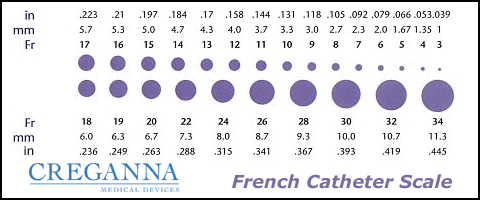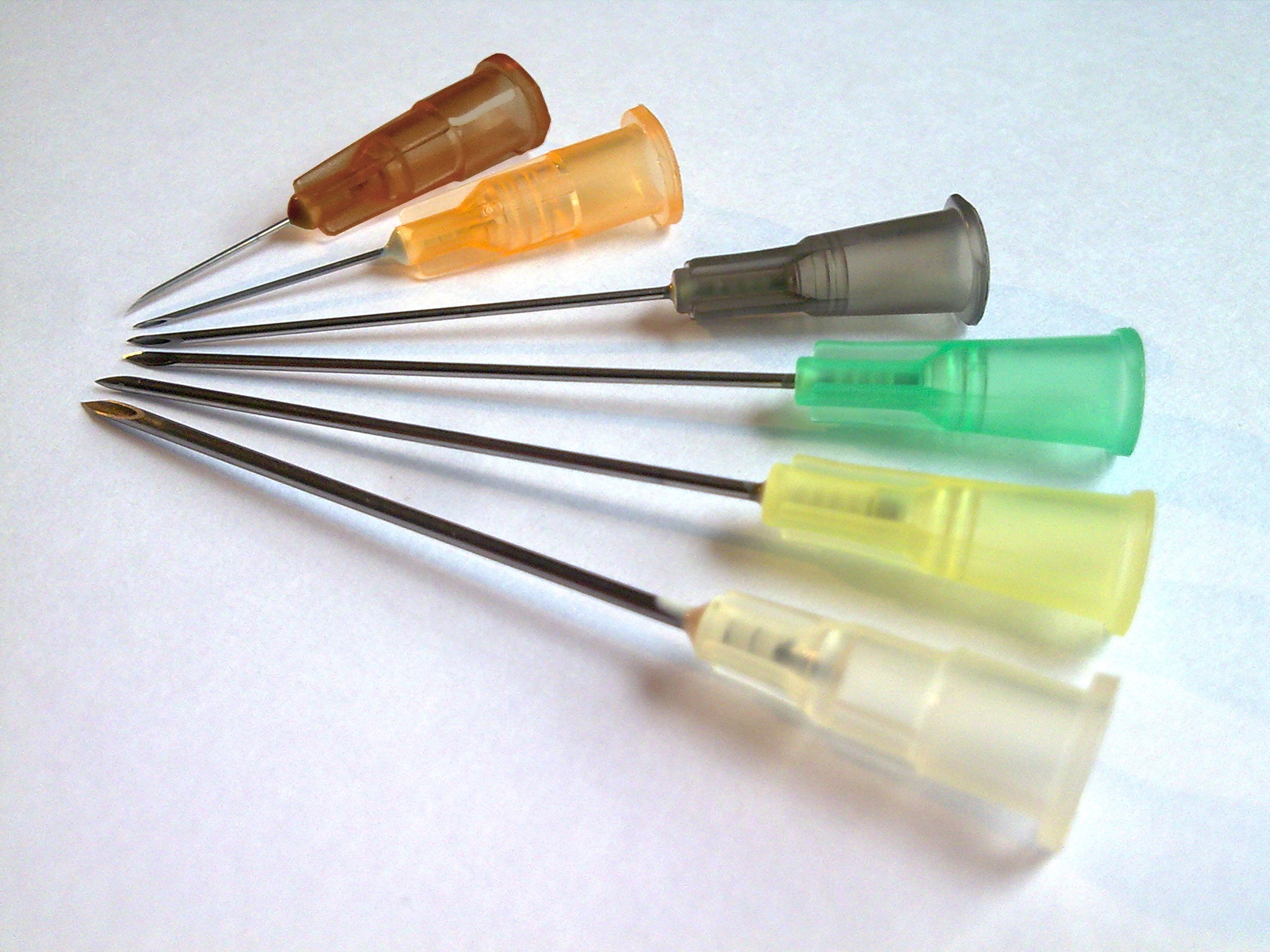|
French Gauge
The French scale, French gauge or Charrière system is commonly used to measure the size of a catheter. It is most often abbreviated as Fr, but can often be seen abbreviated as Fg, FR or F. It may also be abbreviated as CH or Ch (for Charrière, its inventor). However, simply ''gauge'', ''G'' or ''GA'' generally refers to Birmingham gauge. The Charrière is measured by the ''outer'' diameter, and is defined as 1 Fr = 1/3 mm, and thus 1 mm = 3 Fr; therefore the diameter of a round catheter in millimetres can be determined by dividing the French size by 3., For example, if the French size is 9, the diameter is 9/3 = 3.0; mm. It is seen that the French unit is fully redundant with the metric system but introduces potential for rounding errors. This metrication problem is further complicated by the mixed use of metric and imperial units in medical professions using catheters. An increasing French size corresponds to a larger external diameter. This is contrary to Birmingham gauge ... [...More Info...] [...Related Items...] OR: [Wikipedia] [Google] [Baidu] |
Catheter
In medicine, a catheter (/ˈkæθətər/) is a thin tube made from medical grade materials serving a broad range of functions. Catheters are medical devices that can be inserted in the body to treat diseases or perform a surgical procedure. Catheters are manufactured for specific applications, such as cardiovascular, urological, gastrointestinal, neurovascular and ophthalmic procedures. The process of inserting a catheter is ''catheterization''. In most uses, a catheter is a thin, flexible tube (''soft'' catheter) though catheters are available in varying levels of stiffness depending on the application. A catheter left inside the body, either temporarily or permanently, may be referred to as an "indwelling catheter" (for example, a peripherally inserted central catheter). A permanently inserted catheter may be referred to as a "permcath" (originally a trademark). Catheters can be inserted into a body cavity, duct, or vessel, brain, skin or adipose tissue. Functionally, they all ... [...More Info...] [...Related Items...] OR: [Wikipedia] [Google] [Baidu] |
Joseph-Frédéric-Benoît Charrière
Joseph-Frédéric-Benoît Charrière (March 19, 1803 – April 28, 1876) was a Swiss-born French manufacturer of surgical instruments. Charrière was born in Cerniat, in the Canton of Fribourg, Switzerland. He moved to Paris at age 13, and was apprenticed to a manufacturer of knives. In 1820, he founded a company manufacturing surgical instruments, which quickly grew to 400 employees by around 1840, and was world-famous by his death. He became a naturalized French citizen in 1843. He developed and improved a number of instruments, especially hypodermic needles and catheters; the French catheter scale is named after his work. In order to achieve this, Charrière benefitted from at the time newly developed materials such as nickel silver, stainless steel, and rubber. Several of his apprentices also became well-known instrument makers, including Georges-Guillaume-Amatus Lüer, Louis-Joseph Mathieu, and Adolphe Collin in Paris; Josef Leiter in Vienna; and Camillus Nyrop in Copenhag ... [...More Info...] [...Related Items...] OR: [Wikipedia] [Google] [Baidu] |
Birmingham Gauge
The Birmingham gauge is a wire gauge system, and is also used to specify thickness or diameter of hypodermic needles and tube products. Terminology Birmingham gauge is also known as the Stubs Iron Wire Gauge or Birmingham Wire Gauge. It is not the same as, though similar to, the Stubs Steel Wire Gauge. Birmingham gauge is often simply termed Gauge, with the abbreviation G. However, this should not be confused with French gauge. System The gauge starts at the lowest gauge number of 5Ø or 00000, corresponding to the largest size of , and runs to the highest gauge number of 36, corresponding to the smallest size of . Size steps between gauges range from between high gauge numbers to between the two lowest gauge numbers and do not correspond to a particular mathematical pattern, although for the most part the steps get smaller with increasing gauge number. Concerning wire and fine tubing, the gauge number is used to specify the outside diameter of the product, whereas for larg ... [...More Info...] [...Related Items...] OR: [Wikipedia] [Google] [Baidu] |
Round-off Error
A roundoff error, also called rounding error, is the difference between the result produced by a given algorithm using exact arithmetic and the result produced by the same algorithm using finite-precision, rounded arithmetic. Rounding errors are due to inexactness in the representation of real numbers and the arithmetic operations done with them. This is a form of quantization error. When using approximation equations or algorithms, especially when using finitely many digits to represent real numbers (which in theory have infinitely many digits), one of the goals of numerical analysis is to estimate computation errors. Computation errors, also called numerical errors, include both truncation errors and roundoff errors. When a sequence of calculations with an input involving any roundoff error are made, errors may accumulate, sometimes dominating the calculation. In ill-conditioned problems, significant error may accumulate. In short, there are two major facets of roundoff errors ... [...More Info...] [...Related Items...] OR: [Wikipedia] [Google] [Baidu] |
Metrication
Metrication or metrification is the act or process of converting to the metric system of measurement. All over the world, countries have transitioned from local and traditional units of measurement to the metric system. This process began in France during the 1790s, and is still continuing more than 200 years later, with the modern International System of Units, as the metric system has not yet been fully adopted in all countries and areas. Overview Most countries now have the metric system as their official system of weights and measures. Some have adopted it as their official system but have not yet completed the process of metrication. Some others have not made any commitment to adopting it. There is not a general consensus in the sources as to the number of countries that fall into each of these categories. According to a 2011 doctoral dissertation by Hector Vera, as of 2010, a total of seven countries had not "adopted the metric system as their exclusive system of measur ... [...More Info...] [...Related Items...] OR: [Wikipedia] [Google] [Baidu] |
French Catheter Scale
The French scale, French gauge or Charrière system is commonly used to measure the size of a catheter. It is most often abbreviated as Fr, but can often be seen abbreviated as Fg, FR or F. It may also be abbreviated as CH or Ch (for Charrière, its inventor). However, simply ''gauge'', ''G'' or ''GA'' generally refers to Birmingham gauge. The Charrière is measured by the ''outer'' diameter, and is defined as 1 Fr = 1/3 mm, and thus 1 mm = 3 Fr; therefore the diameter of a round catheter in millimetres can be determined by dividing the French size by 3., For example, if the French size is 9, the diameter is 9/3 = 3.0; mm. It is seen that the French unit is fully redundant with the metric system but introduces potential for rounding errors. This metrication problem is further complicated by the mixed use of metric and imperial units in medical professions using catheters. An increasing French size corresponds to a larger external diameter. This is contrary to Birmingham gauge ... [...More Info...] [...Related Items...] OR: [Wikipedia] [Google] [Baidu] |
Catheters
In medicine, a catheter (/ˈkæθətər/) is a thin tube made from medical grade materials serving a broad range of functions. Catheters are medical devices that can be inserted in the body to treat diseases or perform a surgical procedure. Catheters are manufactured for specific applications, such as cardiovascular, urological, gastrointestinal, neurovascular and ophthalmic procedures. The process of inserting a catheter is ''catheterization''. In most uses, a catheter is a thin, flexible tube (''soft'' catheter) though catheters are available in varying levels of stiffness depending on the application. A catheter left inside the body, either temporarily or permanently, may be referred to as an "indwelling catheter" (for example, a peripherally inserted central catheter). A permanently inserted catheter may be referred to as a "permcath" (originally a trademark). Catheters can be inserted into a body cavity, duct, or vessel, brain, skin or adipose tissue. Functionally, they all ... [...More Info...] [...Related Items...] OR: [Wikipedia] [Google] [Baidu] |




.jpg)
